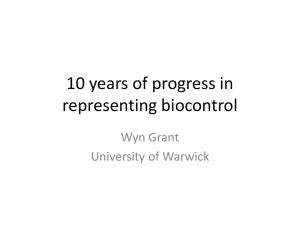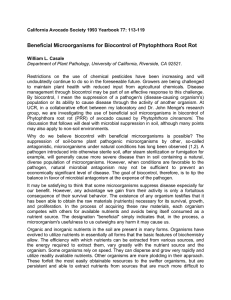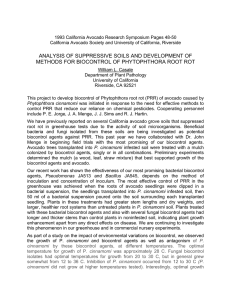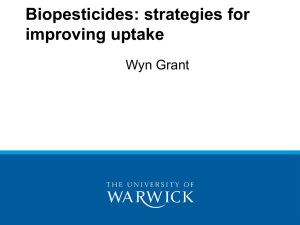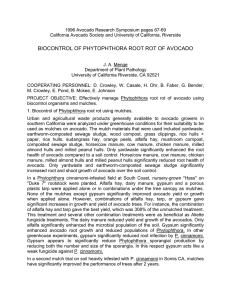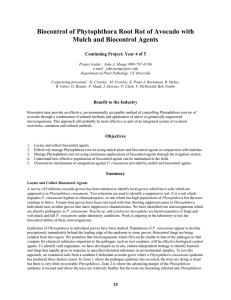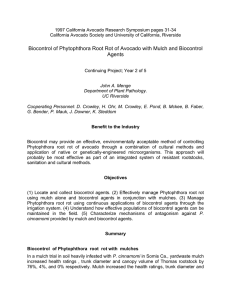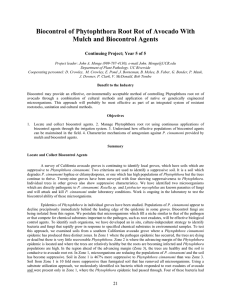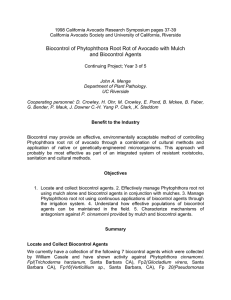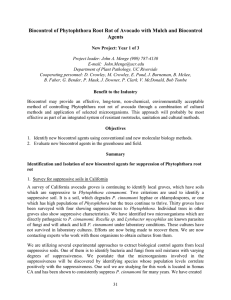1992 Summary of Avocado Research pages 32-34 Avocado Research Advisory Committee
advertisement
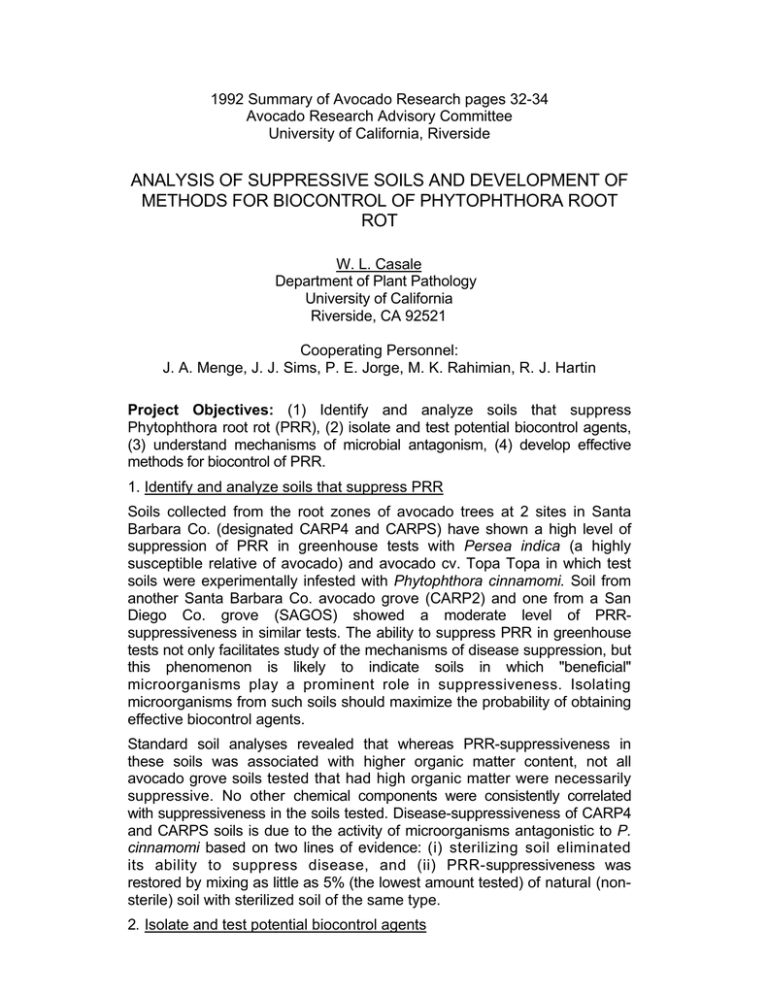
1992 Summary of Avocado Research pages 32-34 Avocado Research Advisory Committee University of California, Riverside ANALYSIS OF SUPPRESSIVE SOILS AND DEVELOPMENT OF METHODS FOR BIOCONTROL OF PHYTOPHTHORA ROOT ROT W. L. Casale Department of Plant Pathology University of California Riverside, CA 92521 Cooperating Personnel: J. A. Menge, J. J. Sims, P. E. Jorge, M. K. Rahimian, R. J. Hartin Project Objectives: (1) Identify and analyze soils that suppress Phytophthora root rot (PRR), (2) isolate and test potential biocontrol agents, (3) understand mechanisms of microbial antagonism, (4) develop effective methods for biocontrol of PRR. 1. Identify and analyze soils that suppress PRR Soils collected from the root zones of avocado trees at 2 sites in Santa Barbara Co. (designated CARP4 and CARPS) have shown a high level of suppression of PRR in greenhouse tests with Persea indica (a highly susceptible relative of avocado) and avocado cv. Topa Topa in which test soils were experimentally infested with Phytophthora cinnamomi. Soil from another Santa Barbara Co. avocado grove (CARP2) and one from a San Diego Co. grove (SAGOS) showed a moderate level of PRRsuppressiveness in similar tests. The ability to suppress PRR in greenhouse tests not only facilitates study of the mechanisms of disease suppression, but this phenomenon is likely to indicate soils in which "beneficial" microorganisms play a prominent role in suppressiveness. Isolating microorganisms from such soils should maximize the probability of obtaining effective biocontrol agents. Standard soil analyses revealed that whereas PRR-suppressiveness in these soils was associated with higher organic matter content, not all avocado grove soils tested that had high organic matter were necessarily suppressive. No other chemical components were consistently correlated with suppressiveness in the soils tested. Disease-suppressiveness of CARP4 and CARPS soils is due to the activity of microorganisms antagonistic to P. cinnamomi based on two lines of evidence: (i) sterilizing soil eliminated its ability to suppress disease, and (ii) PRR-suppressiveness was restored by mixing as little as 5% (the lowest amount tested) of natural (nonsterile) soil with sterilized soil of the same type. 2. Isolate and test potential biocontrol agents We have continued isolation of microorganisms from soil associated with the roots of avocado trees growing at sites tentatively identified as PRRsuppressive. A total of 136 fungi and 131 bacteria have been isolated so far. In dual cultures, 42 of the fungi and 10 of the bacteria produced antibiotics that inhibited the growth of P. cinnamomi. Since fluorescent pseudomonad bacteria have been shown to be promising biocontrol agents for root diseases of other crops, we have looked for these and found 26 of the bacteria isolated from "PRR-suppressive" soils to be of this type. For testing microorganisms for biocontrol ability, P. indica seedlings were transplanted into soil infested with P. cinnamomi. Test microorganisms were applied directly to seedling roots or incorporated into the soil. Eleven fungi (of 136 tested) reduced plant mortality by 40% or more; 6 of these 11 fungi were identified as antibiotic producers. Ten bacteria (of 44 tested) reduced plant mortality by 40% or more; 1 of these 10 bacteria was identified as an antibiotic producer. Since these microorganisms were originally isolated from soil associated with avocado roots, the probability is high that any potential biocontrol agents selected from this group will be compatible with and colonize the avocado rhizosphere. 3. Understand mechanisms of microbial antagonism In order to understand the way in which soil microorganisms inhibit disease caused by P. cinnamomi and to assess possible non-target effects by potential biocontrol agents, we have begun further analysis of antibiotics produced by these microorganisms. Preliminary experiments suggest that the activity of antibiotics from several of our potential biocontrol agents is rather specific for Phytophthora, that is, other microorganisms (even other closely related fungi) do not seem to be sensitive to these compounds. We have now developed and are using a bioassay to identify the active antibiotic compounds in culture filtrates of microorganisms which inhibit growth of P. cinnamomi. Dr. J. J. Sims has been performing chemical separations of culture filtrates and plans to conduct or supervise chemical analyses of the active compounds as they are isolated. We have already separated culture filtrates of one of our potential biocontrol agents, KA190, by high performance liquid chromatography (HPLC) and identified several fractions that have antibiotic activity against P. cinnamomi at high dilutions. 4. Develop effective methods for biocontrol of PRR In cooperation with Dr. J. A. Menge, we have been determining suitable organic substrates, in the form of mulches, for the application of promising biocontrol agents in the field. Laboratory and greenhouse experiments are in progress and field experiments are planned for 1992.
